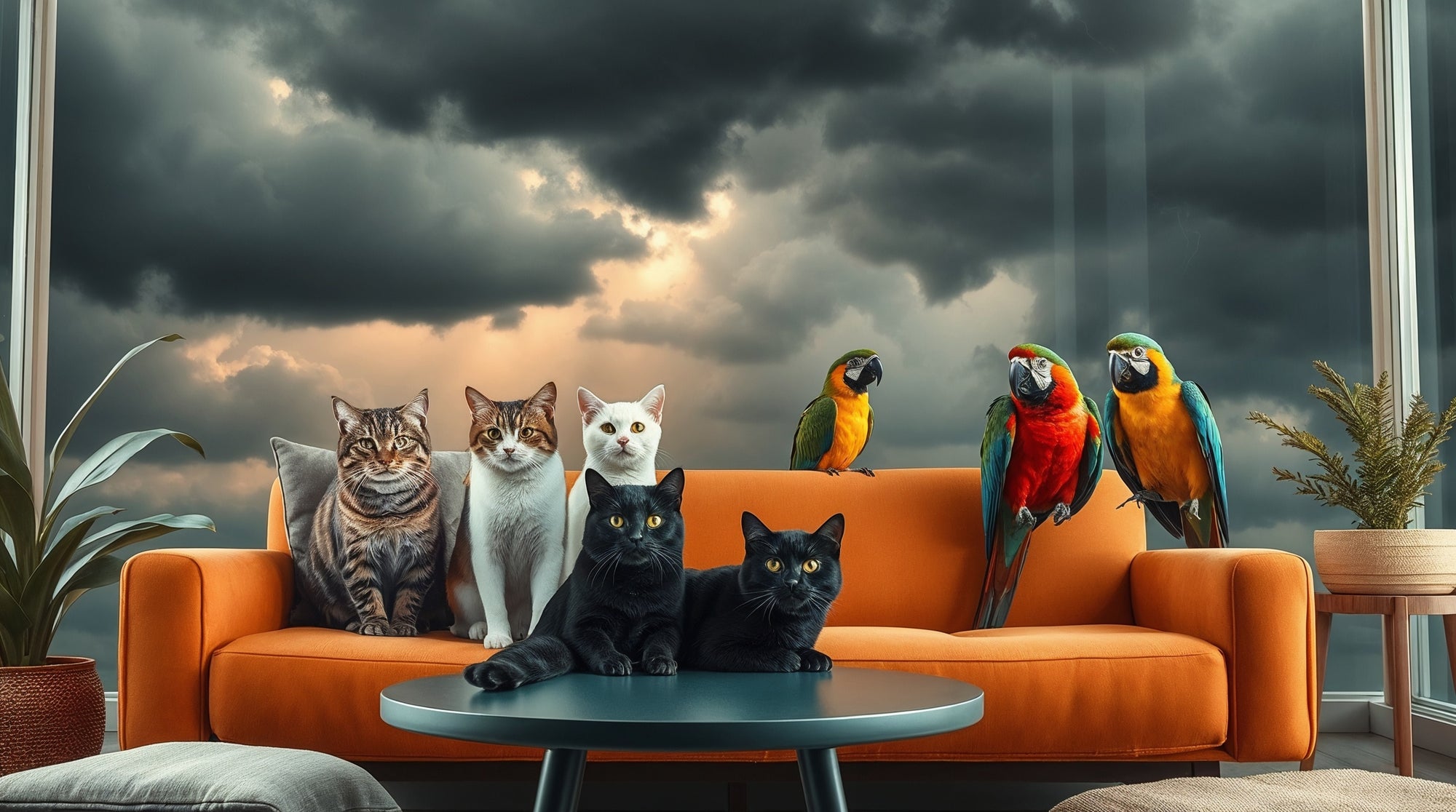Managing a household with multiple pets presents unique challenges and rewards. Whether you have cats and dogs living together, multiple dogs of different sizes, or even more exotic combinations involving birds, rabbits, or other small animals, creating harmony requires thoughtful planning, appropriate equipment, and a deep understanding of each species' needs and behaviors.
Multi-pet households are increasingly common, with many families finding that their pets provide companionship for each other while enriching the family dynamic. However, success doesn't happen automatically. It requires creating environments where each pet feels secure, has access to resources, and can express natural behaviors without conflict. This comprehensive guide will help you establish a peaceful, safe, and comfortable home for all your furry, feathered, or scaled family members.
Understanding Multi-Pet Dynamics
The foundation of a successful multi-pet household lies in understanding how different species and individual animals interact. Dogs are typically pack animals with established social hierarchies, while cats are more territorial and prefer to control their environment. Birds, rabbits, and other small animals have their own social structures and safety needs that must be considered.
Species-specific behaviors can create challenges when animals share space. A dog's natural prey drive might be triggered by a small rabbit or bird, while a cat's hunting instincts could create stress for smaller pets. Understanding these instincts doesn't mean animals can't coexist—it means you need to manage the environment to prevent conflicts and reduce stress.
Age and personality play crucial roles in multi-pet success. Younger animals often adapt more easily to new companions, while established pets may need more time and careful introduction processes. Some animals are naturally more social and adaptable, while others prefer solitude or have strong territorial tendencies.
Individual histories matter significantly. Pets from shelters or rescue organizations may have unknown backgrounds that influence their behavior with other animals. A dog with a history of cat aggression will need careful management, while a cat that lived peacefully with dogs before may adapt more quickly to a new canine sibling.
Essential Safety Equipment and Setup
Safety equipment forms the backbone of multi-pet household management. Baby gates and pet barriers allow you to create separate spaces while maintaining visibility and airflow. These tools are particularly valuable during introduction periods and when unsupervised coexistence isn't yet safe.
Elevated spaces provide security for cats and small animals that feel safer when they can observe their environment from above. Cat trees, wall-mounted shelves, and elevated beds give pets options to retreat when they feel overwhelmed. This vertical territory is particularly important in homes where floor space must be shared.
Secure containment systems protect vulnerable pets from potential predators within the household. Small animals like rabbits, guinea pigs, or birds need enclosures that keep them safe from cats and dogs while allowing them to see and interact with the family. These enclosures should be escape-proof and designed to prevent other pets from reaching inside.
Separate feeding stations prevent food-related conflicts and allow each pet to eat according to their schedule and dietary needs. Food aggression is common among dogs and can create dangerous situations in multi-pet homes. Feeding pets in separate rooms or using barriers ensures each animal can eat peacefully without competition or theft.
Creating Individual Territories
Even the most social animals need personal space and resources they can call their own. Establishing individual territories within shared living spaces helps reduce competition and stress while giving each pet a sense of security.
Cats particularly benefit from having their own rooms or areas where they can retreat when feeling overwhelmed. This space should include their own litter box, food and water stations, comfortable resting spots, and toys. Even cats that get along well with other pets appreciate having private space available when needed.
Dogs also need their own spaces, particularly for sleeping and eating. Individual dog beds, crates, or designated rooms give dogs somewhere to retreat when they need quiet time. This is especially important for older dogs or those with health issues that might make them less tolerant of younger, more energetic pets.
Multiple resource stations prevent competition and ensure all pets have access to necessities. This means multiple water bowls throughout the house, several comfortable resting spots, and enough toys and enrichment items for all pets to have their own. The general rule is to have one resource station per pet plus one extra.
Scent management plays a crucial role in territorial comfort. Allow pets to establish their scents in their individual areas while using tools like pheromone diffusers to create calming environments. Avoid moving pets' belongings between areas, as this can disrupt their sense of territory and security.
Managing Feeding Times and Food Safety
Feeding multiple pets requires careful planning to prevent competition, food stealing, and dietary issues. Different species and even different individuals within species have varying nutritional needs, feeding schedules, and food preferences.
Separate feeding locations are essential for most multi-pet households. Dogs and cats should typically eat in different areas to prevent the dog from eating cat food (which is too high in protein and fat for dogs) and to allow cats to eat at their own pace without pressure. Small animals need feeding setups that protect them from larger pets who might steal their food.
Scheduled feeding times work better than free-feeding in multi-pet homes. Controlled meal times allow you to monitor each pet's food intake, prevent overeating, and reduce food-related aggression. It also makes it easier to administer medications or special diets when needed.
Food storage and safety become more complex with multiple pets. Different types of food must be stored securely to prevent pets from accessing inappropriate diets. Some pets require prescription foods that could be harmful to other animals in the household. Secure storage containers and feeding protocols ensure each pet gets their appropriate nutrition.
Special dietary needs require additional planning. Senior pets, animals with health conditions, or those on prescription diets need protected feeding arrangements. This might involve feeding these pets in separate rooms or using timed feeders that only specific pets can access.
Exercise and Enrichment Strategies
Multi-pet households require thoughtful exercise and enrichment planning to ensure all pets get appropriate physical activity and mental stimulation without conflicts or safety issues.
Individual exercise needs vary significantly between species and even between individuals. A high-energy Border Collie requires much more exercise than a senior cat or a rabbit. Planning exercise routines that meet each pet's needs while considering safety requires creativity and scheduling.
Group activities can provide enrichment for multiple pets simultaneously when done safely. Some dogs and cats enjoy playing together, while others prefer parallel play where they engage in activities near each other without direct interaction. Supervised play sessions allow you to intervene if interactions become too intense.
Enrichment rotation keeps environments interesting for all pets while preventing resource guarding. Rather than having all toys and enrichment items available constantly, rotate items weekly to maintain novelty and interest. This strategy works particularly well for cats and dogs who might otherwise compete over favorite toys.
Species-appropriate enrichment ensures each pet gets mental stimulation suited to their natural behaviors. Cats need hunting-style play, dogs benefit from puzzle feeders and training challenges, while small animals like rabbits need opportunities to dig and explore. Providing appropriate outlets for natural behaviors reduces the likelihood of these behaviors being directed inappropriately toward other pets.
Health and Veterinary Considerations
Multi-pet households face unique health challenges that require proactive management and regular veterinary care. Disease transmission between species, stress-related health issues, and the complexity of managing multiple medication schedules all require attention.
Preventive healthcare becomes more important when multiple animals share space. Vaccinations, parasite prevention, and regular health screenings help prevent disease transmission between pets. Some diseases can spread between species, making comprehensive preventive care essential for all household members.
Quarantine protocols protect existing pets when introducing new animals. New pets should be quarantined and thoroughly examined by a veterinarian before being introduced to resident pets. This process helps prevent the introduction of infectious diseases and allows time for necessary vaccinations and treatments.
Stress monitoring is crucial in multi-pet environments. Stress can suppress immune systems and lead to behavioral problems. Watch for signs of stress in all pets, including changes in eating habits, bathroom behaviors, grooming patterns, or activity levels. Addressing stress early prevents more serious behavioral and health problems.
Emergency preparedness requires planning for multiple animals. Keep medical records, emergency contact information, and basic first aid supplies readily available for all pets. Have plans for evacuating or containing multiple animals if necessary, and ensure all pets are properly identified with collars, tags, and microchips.
Behavioral Management and Training
Successful multi-pet households require ongoing behavioral management and training to maintain harmony and address issues as they arise. This involves both individual training for each pet and management of group dynamics.
Basic obedience training becomes more important in multi-pet homes. All dogs should respond to basic commands like "sit," "stay," "leave it," and "come" to maintain order and prevent conflicts. Even cats can learn basic commands and boundaries that make household management easier.
Resource guarding prevention and management help avoid conflicts over food, toys, beds, and attention. Training pets to wait for permission before accessing resources and teaching "leave it" commands can prevent many potential conflicts. Providing abundant resources reduces competition and the likelihood of guarding behaviors.
Introduction protocols ensure new pets are integrated safely and successfully. Whether adding a new pet to an established household or helping existing pets adjust to changes, following proper introduction procedures reduces stress and increases the likelihood of successful relationships.
Positive reinforcement training works well for all pets and helps create positive associations between animals. Rewarding calm, friendly behavior between pets helps reinforce these interactions and makes them more likely to occur naturally.
Creating Long-Term Harmony
Building lasting harmony in multi-pet households requires ongoing attention to changing dynamics as pets age, health conditions develop, and household circumstances change. What works for a household of young, healthy pets may need adjustment as animals mature.
Routine establishment helps all pets feel secure and reduces anxiety. Consistent feeding times, exercise schedules, and daily routines help pets know what to expect and when. This predictability reduces stress and makes household management easier for humans and animals alike.
Environmental modifications may be needed as pets age or develop health issues. Senior pets might need easier access to food and water, while animals with mobility issues may require ramps or modified sleeping arrangements. Staying flexible and adapting the environment to changing needs maintains comfort for all household members.
Regular assessment of household dynamics helps identify developing issues before they become serious problems. Monthly evaluations of how pets interact, their stress levels, health status, and overall well-being allow for proactive adjustments to management strategies.
The Rewards of Multi-Pet Households
Despite the challenges, multi-pet households offer tremendous rewards for both animals and their human families. Pets often provide companionship for each other, reducing separation anxiety and loneliness. Many pets play together, groom each other, and form strong bonds that enrich their lives significantly.
The entertainment value of watching different species interact and develop relationships brings joy to many families. The unique personalities that emerge when pets feel secure and comfortable can be endlessly fascinating and rewarding to observe.
Multi-pet households also provide practical benefits. Pets can help train new additions to the family, demonstrate proper behaviors, and provide socialization opportunities that might be difficult to arrange otherwise.
Successfully managing a multi-pet household requires dedication, patience, and ongoing attention to each animal's needs. However, with proper planning, appropriate equipment, and commitment to creating a safe and comfortable environment, these households can provide exceptional quality of life for all residents—both human and animal. The key lies in understanding that harmony doesn't happen automatically but results from thoughtful management and genuine care for each individual pet's well-being.

